Safety cars are now a common sight in motorsport. They are piloted by a professional race car driver and often carry a doctor onboard, as well as the medical, fire-fighting, and communications kit to cope with any racing incident. The safety car is also used to control the pace of the racing pack during any period of a race run under warning flags.
Here are some of the most notable safety cars in alphabetical order, with a reminder at the end of why having a good safety car is so important:

Alfa Romeo 4C
The Alfa Romeo 4C was used as the safety car for the 2014 FIA World Touring Car Championship, making its first appearance at the Moroccan round at the Moulay El Hassan Circuit. The 4C then toured the world alongside the racing series and was used at 12 race weekends.

Aston Martin Vantage
This one’s a new entry! The Aston Martin Vantage will share safety car duties with the Mercedes-AMG GT R for the 2021 F1 season and made its first appearance at the Bahrain GP.
The safety car features substantial powertrain, chassis and interior modifications over the road-going Vantage to ensure that it can carry out "the critical role of intervening and controlling the pace of an event involving the fastest racing cars in the world". As such, power from the coupé's twin-turbocharged 4.0-litre V8 is up from a standard 510hp to 535hp, and while torque output is unchanged at 625Nm, it's "sustained for longer".
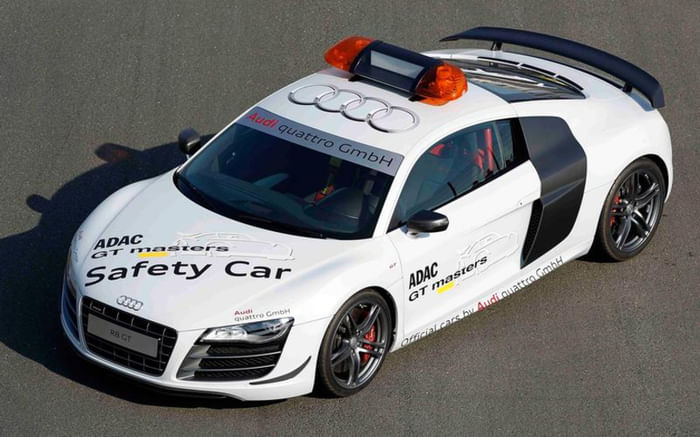
Audi R8
Audi’s R8 has become a popular safety car for several series ever since the German sports car made its debut back in 2007. One of the first appearances for the R8 as a safety car to sweep round after the racing cars on their warm-up and first laps was in the German DTM touring car championship. Two cars were prepared by Audi, with very few changes made to the standard spec other than adding a roll cage, fire extinguishers and roof-mounted lights in case the car had to be used to control the race during a safety car period.
The R8 made its safety car debut at the Norisring in 2007, but it has also seen service for the German ADAC GT Master series and at Le Mans. During a 2016 Le Mans 24 Hours qualifying session in a red flag period, safety car driver Yannick Dalmas earned global notoriety and praise. Dalmas not only saved the R8 from a huge slide in torrentially wet conditions but appeared to then drift the Audi perfectly back under control.
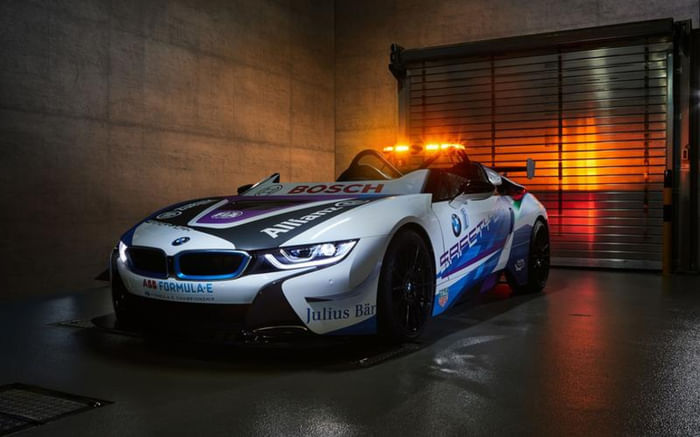
BMW i8 Roadster
It’s fitting the BMW i8 Roadster is used as the safety car for the Formula E series given its electric power. Few other EVs would be able to follow the race cars as they head off on their first lap should the need arise for emergency help. This i8 has been specially modified for its job and is the first FIA-sanctioned safety car with an open cabin, which is achieved by lopping off the windscreen and replacing it with a stubby aero screen.
The i8 Roadster Safety Car also comes with a double hoop roll bar, rear spoiler and unique wheels shod with track-biased tyres. It works in tandem with an i8 Coupe at Formula E races.
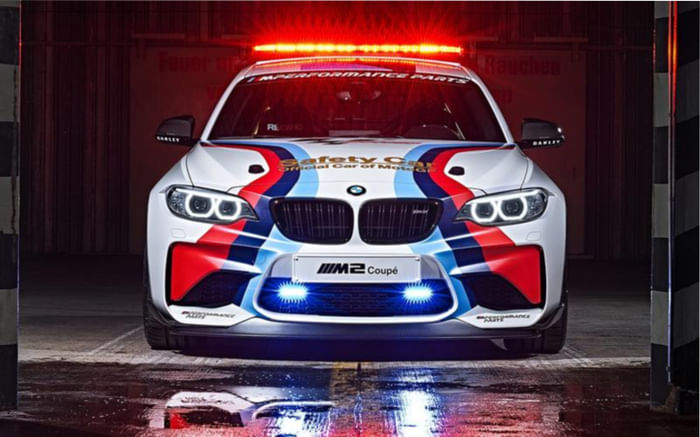
BMW M2
BMW has been supplying the MotoGP championship with safety cars for a long time and the current choice is a 375hp M2 Coupe. It sits on gold wheels with track tyres, and behind the rims are gold-coloured ceramic brake discs to cope with continual hard driving on track.
There’s also race-spec suspension, a roll cage, safety lighting and onboard fire extinguishing equipment. Best of all, as the M2 safety car is not used on the public road, BMW has removed the catalytic converters, silencers and exhaust flap system so the engine can be heard in its full, unadulterated voice.
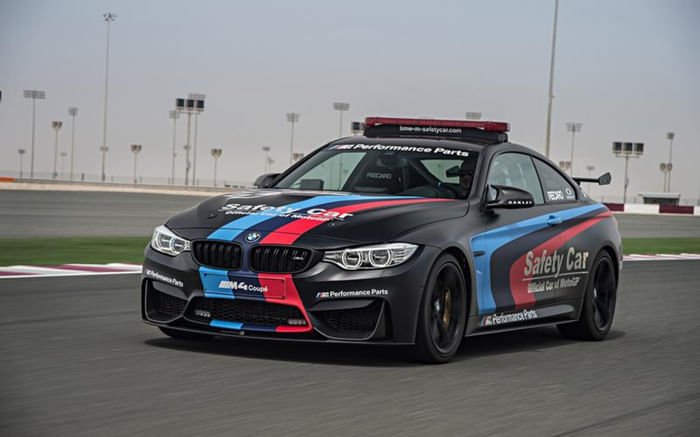
BMW M4
There have been many BMW safety cars over the years, going back to the Z8 and Z4M Coupe, but one of the fans’ favourites is the M4. It became the official safety car of the MotoGP championship in 2015 and made its debut at the opening round in Qatar.
The M4 was made ready for its safety role with the addition of a roll bar, race harnesses and seats, and onboard fire-fighting equipment. It was the most powerful safety car used in MotoGP up to that point and worked alongside a BMW X5 M that carried the race doctor for the warm-up and first laps.
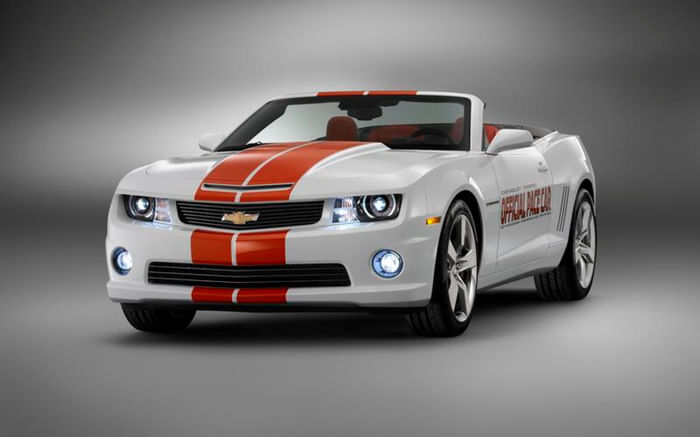
Chevrolet Camaro
As well as taking the fight to its direct pony car rivals on the street, strip and track, the Chevrolet Camaro also fought for the honour of being the Indy Pace Car. This was the early days of the safety car and the main role for the Camaro at its 1967 Indianapolis 500 debut was to lead out the racing cars for the start.
The Camaro became a staple for safety car duties at the Indy 500 and other races in the US, and it’s still being used today in coupe and convertible forms. Chevrolet has also been one of the few car makers to offer replicas of its pace and safety cars for the public to buy. These are usually built in a limited edition run of 500 cars and are eagerly snapped up.
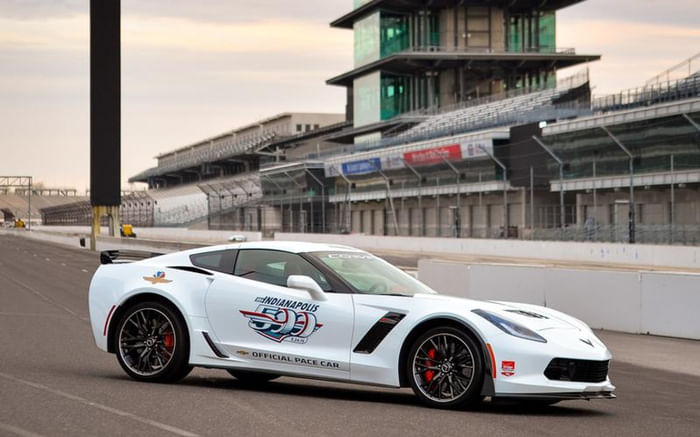
Chevrolet Corvette Z06
A safety car has to be able to keep up with the racing pack and drive quickly when working as a pace car to keep the competition machines up to temperature. This is why the Corvette has proved popular for this role in the US, with several appearances in the job at the Indy 500.
The Z06 version of the Corvette with its 659hp supercharged 6.2-litre V8 was a natural, especially when fitted out with stripped cabin, roll cage and safety gear. It can trace its ancestry back to the 1948 Chevrolet Fleetmaster Six convertible that was the first Indy 500 pace car and was driven by three-time winner of the race Wilbur Shaw.

Honda Civic Type R
Honda has a long association with racing at the Isle of Man TT motorcycle event, but it also has a lengthy history of supplying cars for travelling doctors during the race. Due to the size of the 60.72km track used for the TT, as many as eight Civic Type Rs can be found placed around the course and they are assisted by travelling marshals on Honda Fireblade motorcycles.
As well as the current Civic Type R, the Isle of Man TT has also used other fast Hondas, including the Accord Type R that was also popular with the island’s police force.

Jaguar XJ and S-type R
There’s a long tradition of Jaguar’s being used as safety cars, especially at the Silverstone circuit in the UK. This goes all the way back to an original Series 1 XJ, which was often driven with verve as it followed the racing pack on the first lap.
In later years, several other XJ sedans were converted for similar use, with the rear seats removed to carry fire-fighting equipment. Jaguar also supplied an S-type R for Silverstone’s use, while Jaguar XJ12 and XJR models were used by the Thrust Land Speed Record team.
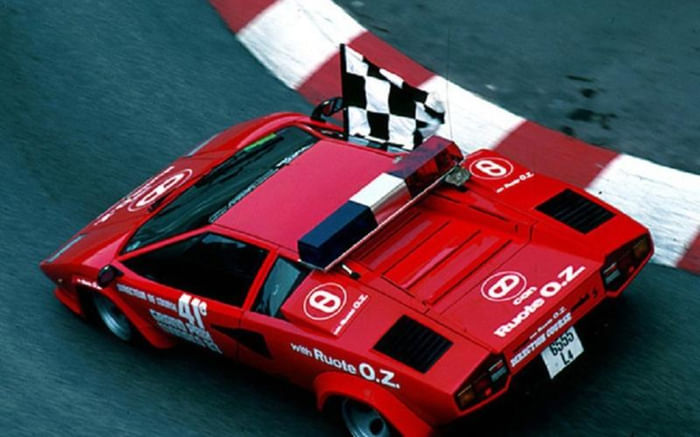
Lamborghini Countach
If you were ever in doubt about Monaco being the epicentre of the jet set lifestyle, the Lamborghini Countach used as a course car for the principality’s Grand Prix settled the question. Just to be sure nobody doubted the Monaco Grand Prix’s status as the jewel in the crown of Formula 1 racing, there were several Countachs on hand as safety cars between 1981 and 1983.
In 1981, at least three Lamborghinis were used, finished in red, blue and gold, and all with light bars attached over the rear engine deck. For 1982, red, white and yellow cars were used. Regardless of the year, the race director had the difficult job of negotiating the Countach’s tiny window opening to wave the relevant flag to the following race drivers.
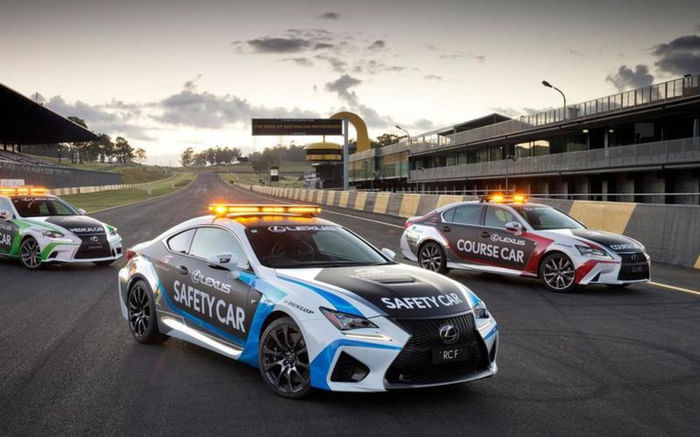
Lexus RC F
Given the Australian fans’ love for their domestic makes in the V8 Supercars series, the choice of a Lexus RC F as safety car could have been contentious. However, the RC F had all the right ingredients thanks to its 477hp 5.0-litre V8 motor. As well as the obligatory lurid paint scheme and roof-mounted flashing light bar, the Lexus had race seats, harnesses and roll cage fitted.
Lexus also supplied GS350 F Sport as the course car and an IS350 F Sport as the medical car. All three cars ran on track-biased tyres to cope with the demands of high-speed driving on track.
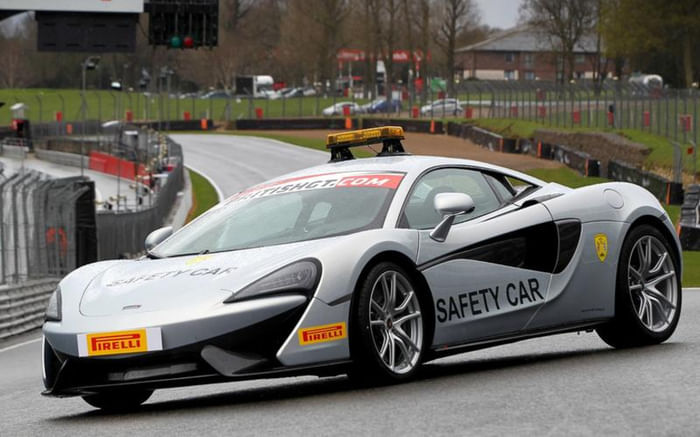
McLaren 570S
Plenty of McLaren cars feature in GT racing, but the company also supplied a 570S safety car for the 2016 British GT Championship. It made its first appearance at the opening Brands Hatch round and the silver car came with plenty of stickers and a roof-mounted light bar.
The 570hp 570S has a top speed of 328kph, which made it ideal for leading the racing pack if there was a safety car period as it could run at a similar speed while keeping any marshals or rescue crews safe.
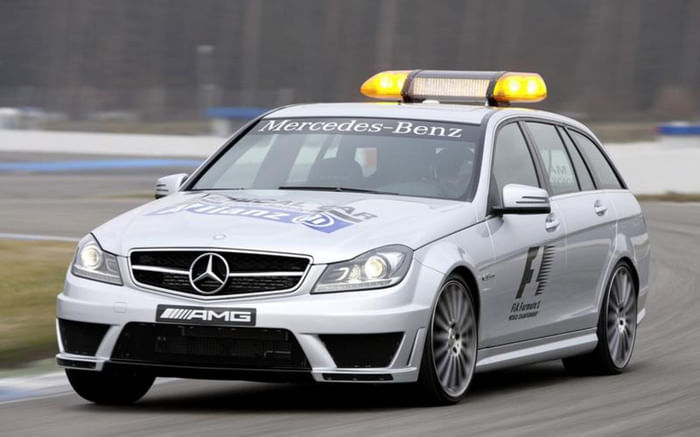
Mercedes-AMG C63
The 463hp Mercedes-AMG C63 was one of the all-time great safety cars and was a regular at F1 Grands Prix between 2008 and 2015. The performance from the 6.3-litre V8 gave it the speed, while the roomy cabin and boot meant the C63 could carry driver and doctor co-driver in race seats with four-point harnesses. There was also space for communications with track officials, fire equipment, rescue kit including defibrillator and respirator.
The current AMG C63 estate is used as a medical car in F1. After a horrific fiery crash in November 2020 involving Romain Grosjean, it was on the scene in a remarkable 10 seconds, driven by former Formula 3 champion Alan van der Merwe; he and a colleague helped Grosjean to escape the wreck with only minor injuries. Power comes from a 4.0-litre V8 that delivers 509hp and, importantly for this role, 0-100kph in just 4.1sec.
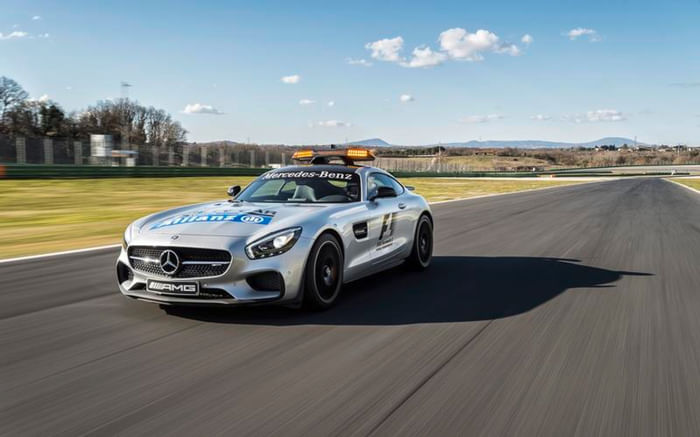
Mercedes-AMG GT
Since 1997, Mercedes has supplied Formula 1’s safety cars and the Mercedes-AMG GT S has been on duty from 2015. The official Safety Car driver Bernd Maylander helped develop the car thanks to his experience racing in the German Touring Car series. As well as its performance that lets the race cars remain at a safe working temperature during a safety car period, the AMG also has purpose-made lightweight forged alloy wheels.
The engine for this safety car is standard, but it differs from road-going models with a carbon fibre scoop on the roof to carry the light bar. This scooper has been designed to minimise aero drag, while the light bar has a television camera mounted in it. It also has strobing headlights and tail lamps to make the safety car even more conspicuous on track.
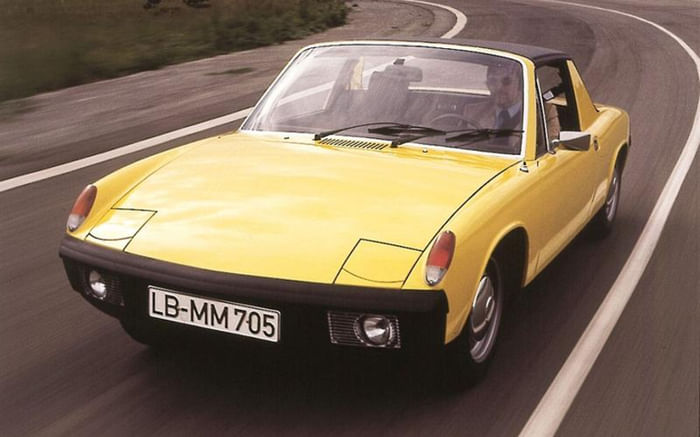
Porsche 914
While the Porsche 911 has been a common safety car choice since the mid-1970s, the mid-engined 914 was in use before its more famous sister model. The 914 was also the first safety car to be used in Formula 1, where a bright yellow version made its debut at the 1973 Canadian Grand Prix driven by Eddie Wietzes.
When Jody Scheckter and Francois Cevert collided in that race, the 914 was deployed to control the pace of the race while rescue crews dealt with the collision. However, there was controversy as the safety car appeared in front of the wrong car, allowing several of the leaders to gain a lap on their rivals.

Porsche Panamera Turbo
Given the unique demands placed on a safety car, the Porsche Panamera could almost have been designed with the role in mind. Its first outing as a safety car was in the 2011 American Le Mans Series where the Turbo model’s 500hp, four-wheel drive and extra cabin space compared to a 911 made it ideal.
As well as the small light bar on the roof and exterior graphics, the Panamera was fitted with emergency medical kit and fire-fighting equipment. The Panamera also went on to be used as the safety car for the British Touring Car Championship and other racing series around the world.

Renault Clio 16v
The Renault Clio first appeared as a safety car in Formula 1 at the 1995 Monaco Grand Prix in infamous circumstances. As Taki Inoue’s Footwork car was being towed back to the pits, none other than legendary rally driver Jean Ragnotti was coming round in a Clio 16v to sweep behind at the end of the practice session. Exiting the Swimming Pool section, Ragnotti couldn’t avoid the rear of the hapless Footwork and crashed into the back.
In 1996, a Clio Williams was back on duty for the Argentine Grand Prix and completed its duties without damaging any Formula 1 machinery.

Tatra T-623 R
Perhaps the least likely of all safety cars, the Tatra T-623 R was used at the 1995 Hungarian Grand Prix, though Tatras had been used as far back as 1986. The 1995 race is remembered for the Tatra failing as a safety car and running over the unfortunate Taki Inoue, whose Footwork Hart car had suffered an engine fire.
As Inoue fetched a fire extinguisher from the marshals, the Tatra’s driver couldn’t stop in time on the grass and ran into the Japanese driver. It left Inoue bruised and lying on the ground while his racing car smoked at the side of the track.
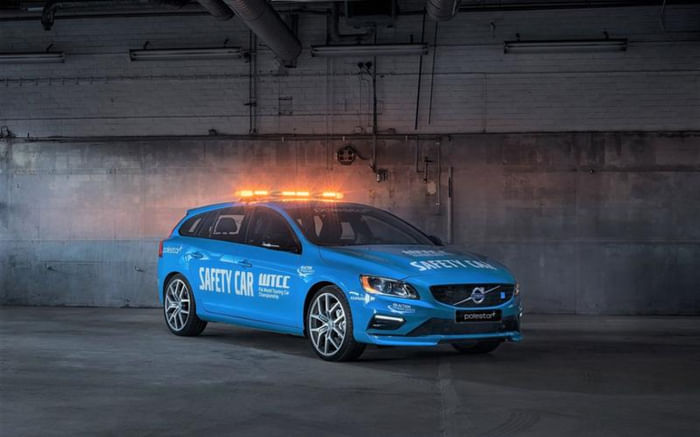
Volvo V60 Polestar
Volvo billed its V60 Polestar as the ‘safest ever Safety Car’ when it took up the job in 2016 for the World Touring Car Championship. The V60 was on duty from the first race that year at Circuit Paul Ricard in France. The driver and observer sat in race seats and held in by four-point harnesses, while communication kit and a roll cage were also installed.
The V60’s boot was filled with rescue and medical equipment, while four-wheel drive and a 367hp 2.0-litre engine took care of the performance side. It offered 0-100ph in 4.8 seconds and a 249kph top speed.
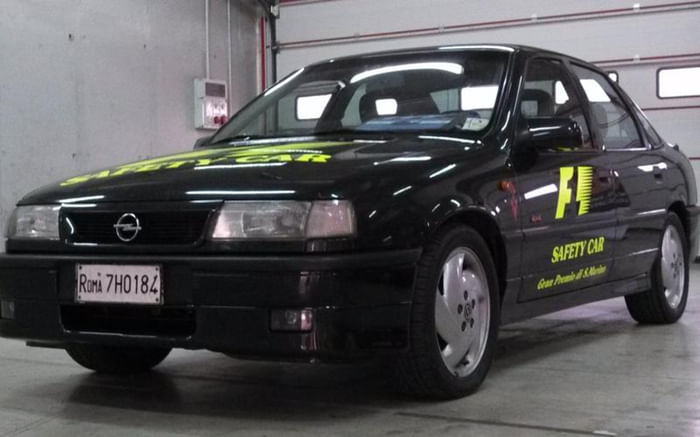
Opel Vectra Turbo
And last and most probably least… There’s a reason modern safety cars are all high performance models and the Opel Vectra Turbo is it. The Opel was used as the safety car at the San Marino Grand Prix in 1994. When Pedro Lamy and JJ Lehto collided on the first lap, the Opel came out as safety car. However, the drivers’ pre-race concerns that this souped-up family sedan would not be suitable in the role were soon realised as it could not go fast enough to maintain temperature and thus grip in the tyres of the vastly more powerful Formula 1 cars.
Ayrton Senna even drove alongside the Opel, gesticulating with his hands for its driver to go faster, but the Opel’s brakes had already been fried under the pressure of fast track driving. After the rolling re-start, Senna’s Williams FW16 crashed on lap seven at the 306kph Tamburello corner. It’s thought by many that he may have lost steering traction when the car bottomed out on a bump on the track as it was riding low on tyres that were too soft due to losing pressure and heat because of the enforced previously slow pace. Senna died principally as a result of a front suspension part penetrating his helmet visor at high velocity.






























